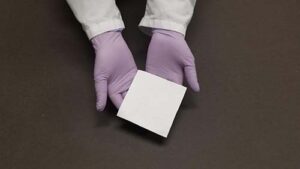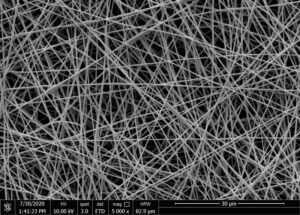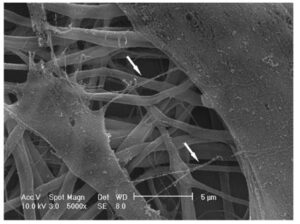OmegaSkin™ Patches
Non-healing skin wounds, burns and pressure ulcers affect nearly five million Americans each year and translate into multi-billions of dollars of healthcare costs annually. Current treatments include skin grafting (another wound), natural or synthetic acellular skin substitutes (cadaver, porcine, placental, others) and many advanced cellular therapies that are expensive, may have limited efficacy, or are not readily available for immediate use.
Proposed Solution
Our OmegaSkin™ (OmegaSkin) technology utilizes soy protein isolate, a common alimentary “green protein” in a high-tech biomedical platform tool that will disrupt current and emerging problems with animal-protein based wound dressings and meet the need to provide an affordable, plant-based scaffold for wound management. Sheets of OmegaSkin are manufactured by electrospinning and made available for use in any environment without the need for refrigeration or special handling.

OmegaSkin Patch

SEM Micrograph of OmegaSkin

Our preclinical studies with rat and pig models indicate that electrospun soy-based wound matrices lead to improved wound healing, as inferred from enhanced deposition of new collagen. In full thickness cutaneous wounds in both rodent nd porcine models, our fibrous soy scaffolds results were comparable but with better ethical considerations regarding animal products than other leading wound management products.
The value derived from using OmegaSkin readily available skin substitute patches are:
- Efficacy proven in multiple models of wound healing
- More socially acceptable plant-based product as compared to pig, cow, cadaver or placental products
- Patients heal with better appearance Minimal to no scarring
- Cost advantage
- Safety
- Easy to apply
- Addresses large unmet clinical need to heal chronic and acute wounds effectively
